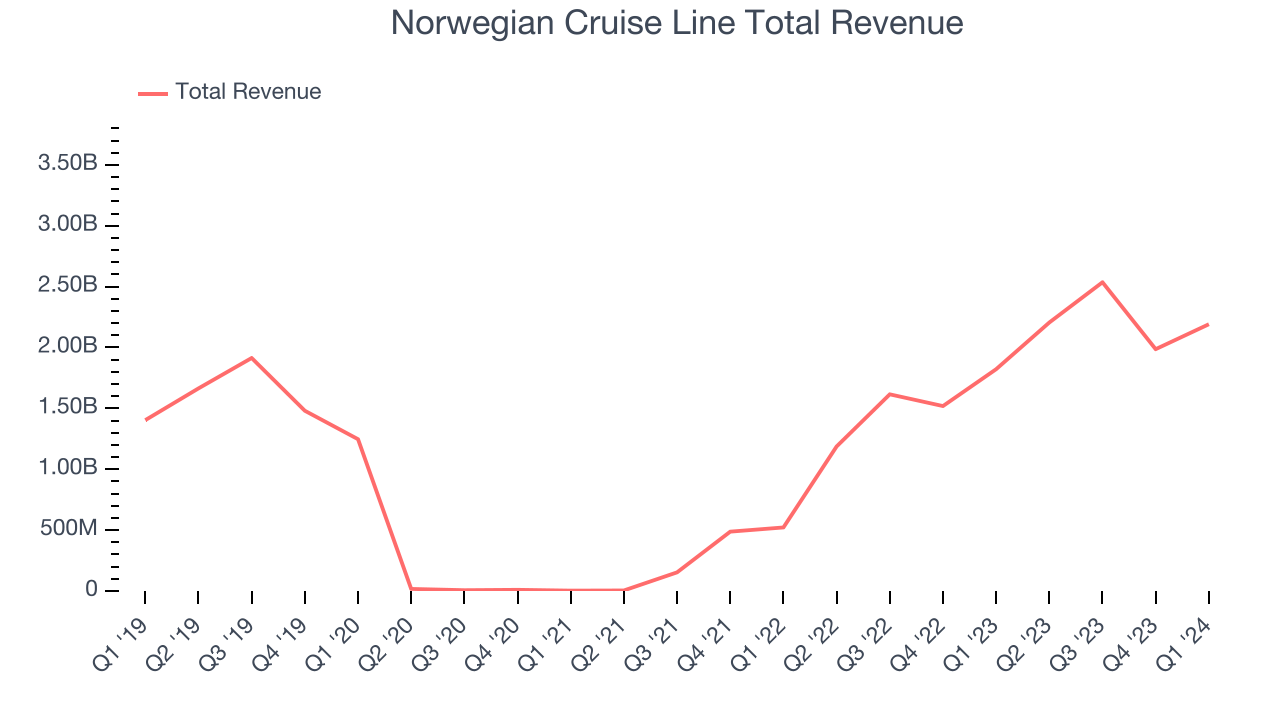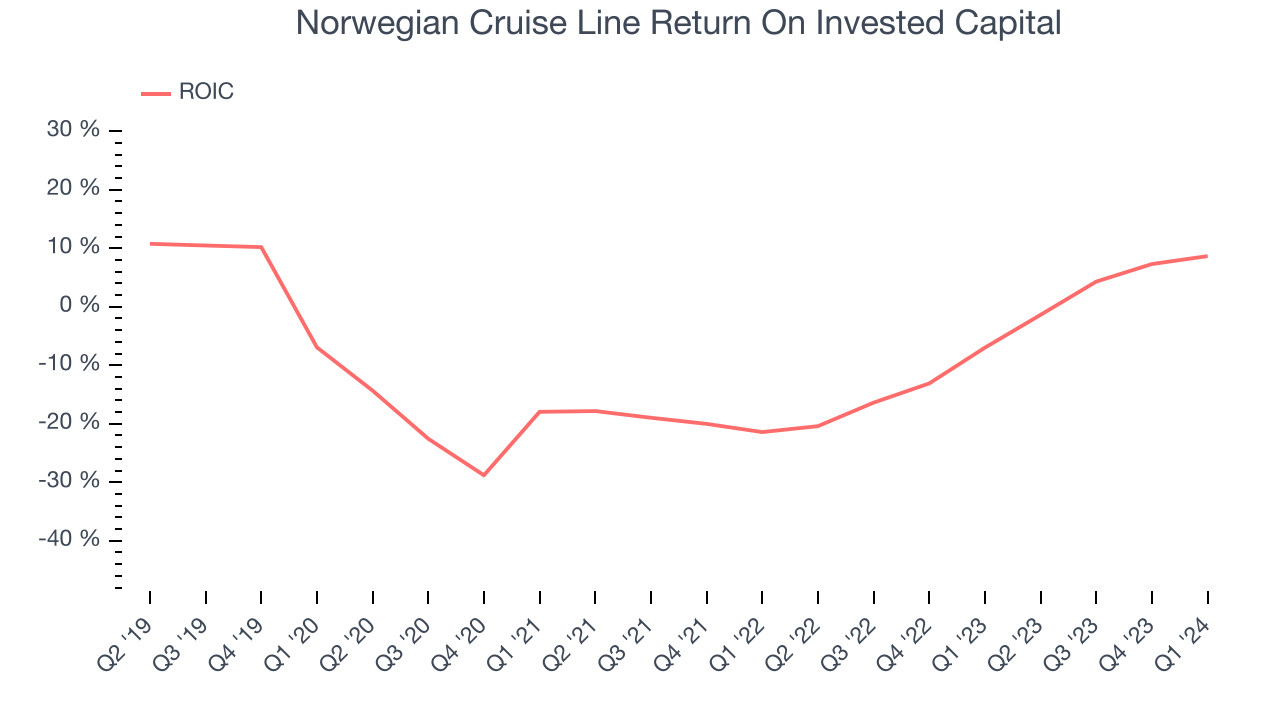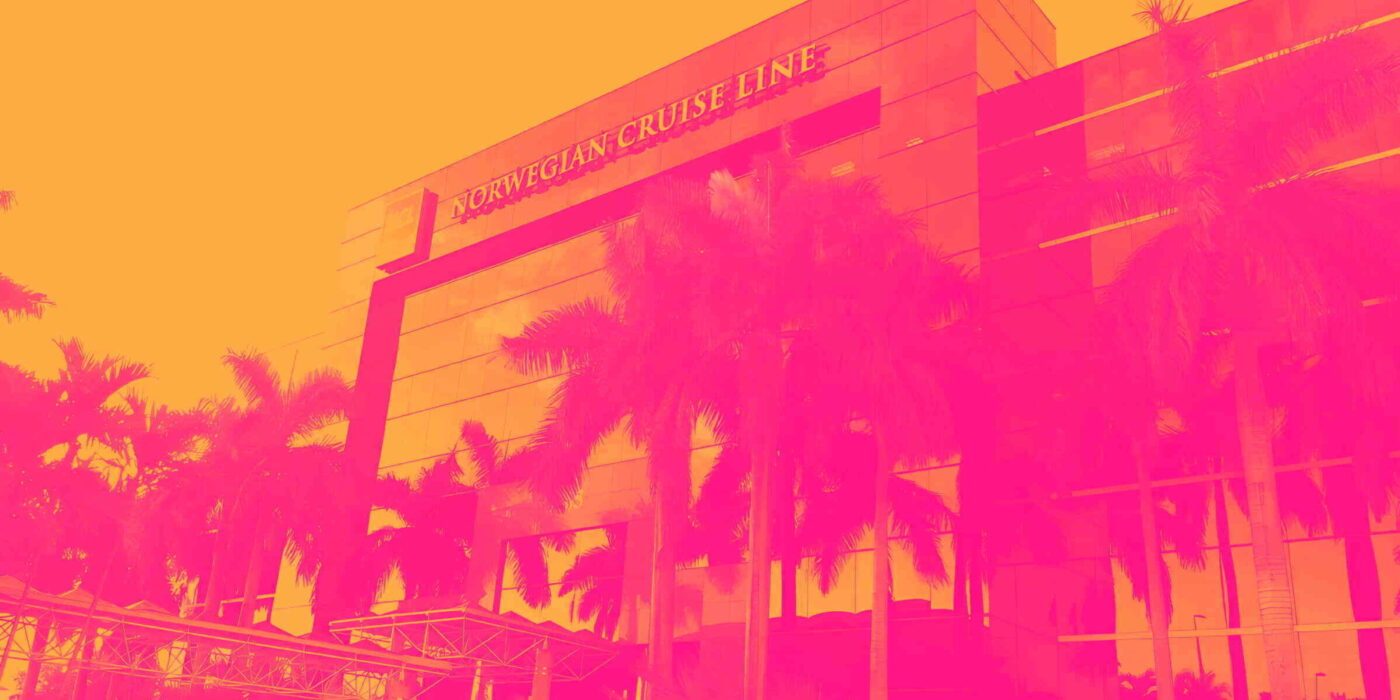Cruise company Norwegian Cruise Line (NYSE:NCLH) missed analysts' expectations in Q1 CY2024, with revenue up 20.3% year on year to $2.19 billion. It made a non-GAAP profit of $0.16 per share, improving from its loss of $0.30 per share in the same quarter last year.
Norwegian Cruise Line (NCLH) Q1 CY2024 Highlights:
- Revenue: $2.19 billion vs analyst estimates of $2.24 billion (2% miss)
- EPS (non-GAAP): $0.16 vs analyst estimates of $0.12 (36.5% beat)
- EPS (non-GAAP) Guidance for Q2 CY2024 is $0.32 at the midpoint, roughly in line with what analysts were expecting
- Gross Margin (GAAP): 36.7%, up from 29.7% in the same quarter last year
- Free Cash Flow of $548.3 million is up from -$388.7 million in the previous quarter
- Passenger Cruise Days: 6.11 million
- Market Capitalization: $8.12 billion
With amenities like a full go-kart race track built into its ships, Norwegian Cruise Line (NYSE:NCLH) is a premier global cruise company.
Norwegian Cruise Line's fleet consists of about 30 ships, each offering different guest experiences. The ships sail to over 490 destinations worldwide, including the Caribbean, Alaska, Europe, South America, and the Far East.
Norwegian Cruise Line pioneered the "Freestyle Cruising" category by offering guests the freedom and flexibility to design their ideal cruise vacation on their schedule. This resort-style cruise vacation has no fixed dining times, formal dress codes, or pre-assigned seating, along with a wealth of entertainment options and activities.
The company's ships offer an array of amenities and entertainment options including award-winning dining experiences, Broadway-style shows, water parks, and modern fitness centers. Norwegian Cruise Line is also known for its unique ship design, with many vessels featuring The Waterfront, a unique oceanfront promenade, and The Haven, an exclusive retreat with private amenities.
Hotels, Resorts and Cruise Lines
Hotels, resorts, and cruise line companies often sell experiences rather than tangible products, and in the last decade-plus, consumers have slowly shifted from buying "things" (wasteful) to buying "experiences" (memorable). In addition, the internet has introduced new ways of approaching leisure and lodging such as booking homes and longer-term accommodations. Traditional hotel, resorts, and cruise line companies must innovate to stay relevant in a market rife with innovation.
Norwegian Cruise Line's primary competitors include Carnival (NYSE:CCL), Royal Caribbean (NYSE:RCL), Disney Cruise Line (owned by Disney NYSE:DIS), and private companies Viking Ocean Cruises and MSC Cruises.Sales Growth
A company’s long-term performance can give signals about its business quality. Even a bad business can shine for one or two quarters, but a top-tier one may grow for years. Norwegian Cruise Line's annualized revenue growth rate of 7.7% over the last five years was weak for a consumer discretionary business.  Within consumer discretionary, a long-term historical view may miss a company riding a successful new property or emerging trend. That's why we also follow short-term performance. Norwegian Cruise Line's annualized revenue growth of 176% over the last two years is above its five-year trend, suggesting some bright spots.
Within consumer discretionary, a long-term historical view may miss a company riding a successful new property or emerging trend. That's why we also follow short-term performance. Norwegian Cruise Line's annualized revenue growth of 176% over the last two years is above its five-year trend, suggesting some bright spots.
This quarter, Norwegian Cruise Line generated an excellent 20.3% year-on-year revenue growth rate, but its $2.19 billion of revenue fell short of Wall Street's high expectations. Looking ahead, Wall Street expects sales to grow 5.3% over the next 12 months, a deceleration from this quarter.
Operating Margin
Operating margin is an important measure of profitability. It’s the portion of revenue left after accounting for all core expenses–everything from the cost of goods sold to advertising and wages. Operating margin is also useful for comparing profitability across companies with different levels of debt and tax rates because it excludes interest and taxes.
Norwegian Cruise Line was profitable over the last eight quarters but held back by its large expense base. Its average operating margin of 1.9% has been among the worst in the consumer discretionary sector.This quarter, Norwegian Cruise Line generated an operating profit margin of 10%, up 9.4 percentage points year on year.
Over the next 12 months, Wall Street expects Norwegian Cruise Line to become more profitable. Analysts are expecting the company’s LTM operating margin of 12.8% to rise to 14.1%.EPS
Analyzing long-term revenue trends tells us about a company's historical growth, but the long-term change in its earnings per share (EPS) points to the profitability and efficiency of that growth–for example, a company could inflate its sales through excessive spending on advertising and promotions.
Over the last five years, Norwegian Cruise Line's EPS dropped 237%, translating into 27.5% annualized declines. Thankfully, Norwegian Cruise Line has bucked its trend as of late, growing its EPS over the last three years. We'll see if the company's growth is sustainable.
In Q1, Norwegian Cruise Line reported EPS at $0.16, up from negative $0.30 in the same quarter last year. This print beat analysts' estimates by 36.5%. Over the next 12 months, Wall Street expects Norwegian Cruise Line to grow its earnings. Analysts are projecting its LTM EPS of $1.03 to climb by 29.2% to $1.34.
Cash Is King
If you've followed StockStory for a while, you know we emphasize free cash flow. Why, you ask? We believe that in the end, cash is king, and you can't use accounting profits to pay the bills.
While Norwegian Cruise Line posted positive free cash flow this quarter, the broader story hasn't been so clean. Over the last two years, Norwegian Cruise Line's demanding reinvestments to stay relevant with consumers have drained company resources. Its free cash flow margin has been among the worst in the consumer discretionary sector, averaging negative 8.2%.
Norwegian Cruise Line's free cash flow came in at $548.3 million in Q1, equivalent to a 25% margin and up 106% year on year.
Return on Invested Capital (ROIC)
EPS and free cash flow tell us whether a company was profitable while growing revenue. But was it capital-efficient? A company’s ROIC explains this by showing how much operating profit a company makes compared to how much money the business raised (debt and equity).
Norwegian Cruise Line's five-year average return on invested capital was negative 8.9%, meaning management lost money while trying to expand the business. Its returns were among the worst in the consumer discretionary sector.

The trend in its ROIC, however, is often what surprises the market and drives the stock price. Over the last few years, Norwegian Cruise Line's ROIC averaged 13.3 percentage point increases. This is a good sign, and we hope the company can continue improving.
Balance Sheet Risk
As long-term investors, the risk we care most about is the permanent loss of capital. This can happen when a company goes bankrupt or raises money from a disadvantaged position and is separate from short-term stock price volatility, which we are much less bothered by.
Norwegian Cruise Line's $13.75 billion of debt exceeds the $559.8 million of cash on its balance sheet. Furthermore, its 6x net-debt-to-EBITDA ratio (based on its EBITDA of $2.09 billion over the last 12 months) shows the company is overleveraged.
At this level of debt, incremental borrowing becomes increasingly expensive and credit agencies could downgrade the company’s rating if profitability falls. Norwegian Cruise Line could also be backed into a corner if the market turns unexpectedly – a situation we seek to avoid as investors in high-quality companies.
We hope Norwegian Cruise Line can improve its balance sheet and remain cautious until it increases its profitability or reduces its debt.
Key Takeaways from Norwegian Cruise Line's Q1 Results
Although Norwegian Cruise Line's revenue missed this quarter, we were impressed by how significantly it blew past analysts' adjusted EBITDA and EPS expectations. That was driven by higher efficiency and leverage on its fixed costs. We were also glad it raised its full-year earnings guidance, slightly exceeding Wall Street's estimates.
Occupancy during the quarter clocked in at 104.6%, and the company noted it received an "unprecedented level of advance ticket sales". These strong numbers likely contributed to its recent decision to build eight new vessels.
Zooming out, we think this was still a decent, albeit mixed, quarter, showing that the company is staying on track. The market was likely expecting more, and the stock is down 4.5% after reporting, trading at $18.05 per share.
Is Now The Time?
Norwegian Cruise Line may have had a fine quarter, but investors should also consider its valuation and business qualities when assessing the investment opportunity.
We cheer for all companies serving consumers, but in the case of Norwegian Cruise Line, we'll be cheering from the sidelines. Its revenue growth has been a little slower over the last five years, and analysts expect growth to deteriorate from here. And while its projected EPS for the next year implies the company's fundamentals will improve, the downside is its declining EPS over the last five years makes it hard to trust. On top of that, its relatively low ROIC suggests it has historically struggled to find compelling business opportunities.
Norwegian Cruise Line's price-to-earnings ratio based on the next 12 months is 14.2x. While there are some things to like about Norwegian Cruise Line and its valuation is reasonable, we think there are better opportunities elsewhere in the market right now.
Wall Street analysts covering the company had a one-year price target of $21.48 per share right before these results (compared to the current share price of $18.05).
To get the best start with StockStory, check out our most recent stock picks, and then sign up for our earnings alerts by adding companies to your watchlist here. We typically have the quarterly earnings results analyzed within seconds of the data being released, and especially for companies reporting pre-market, this often gives investors the chance to react to the results before the market has fully absorbed the information.
